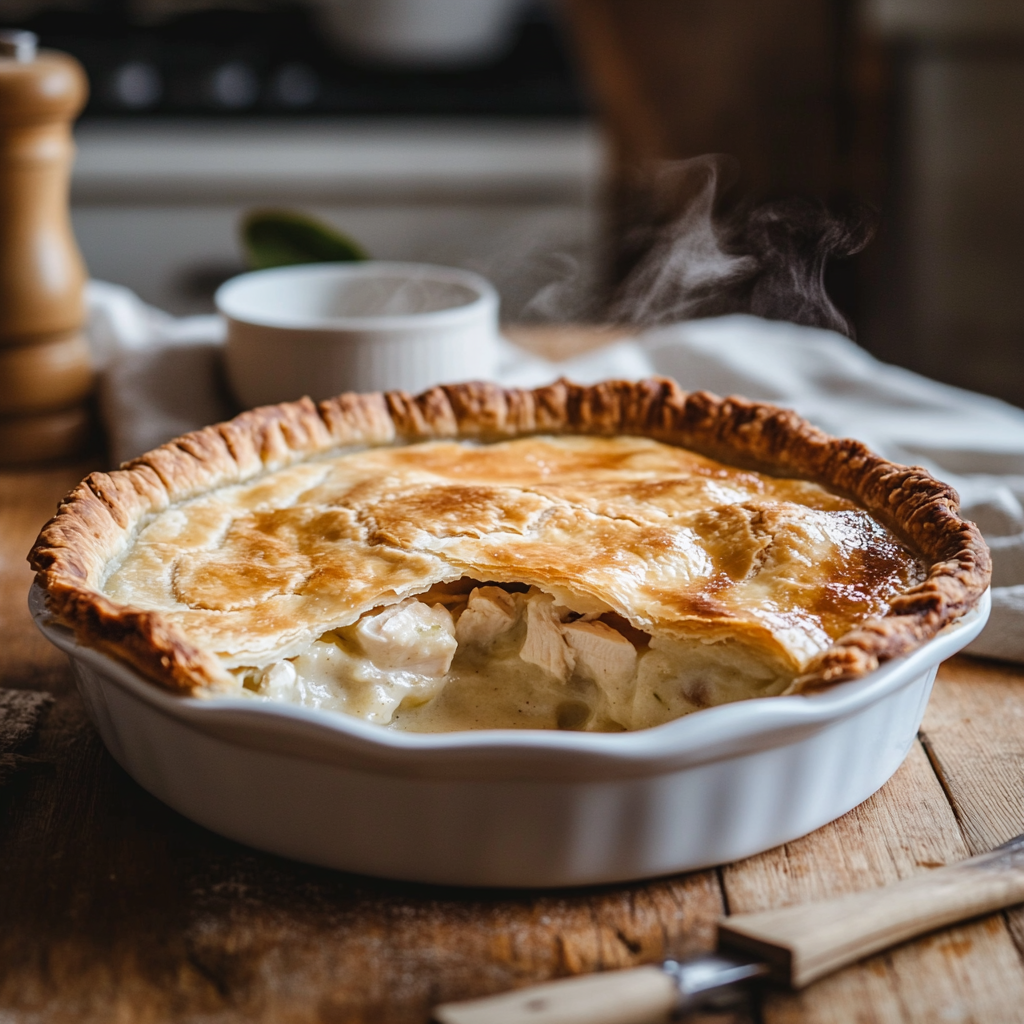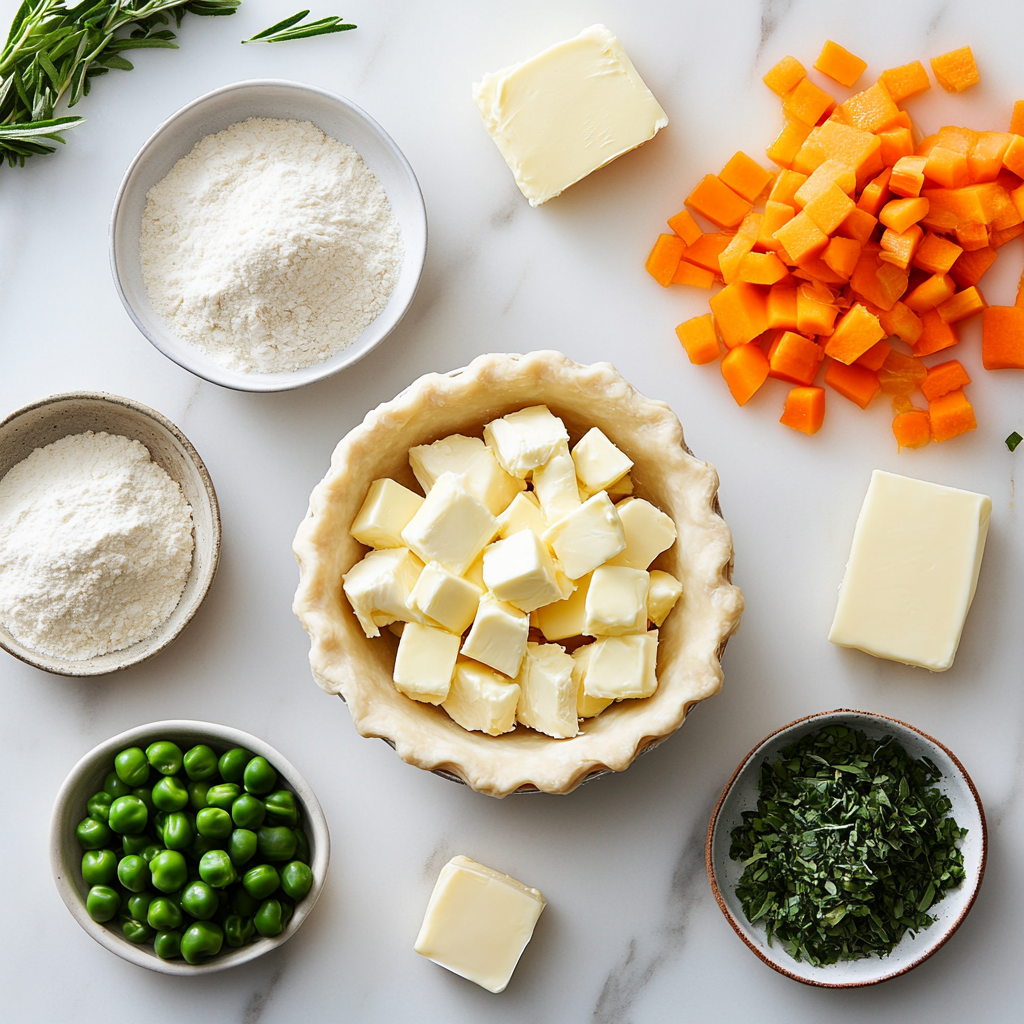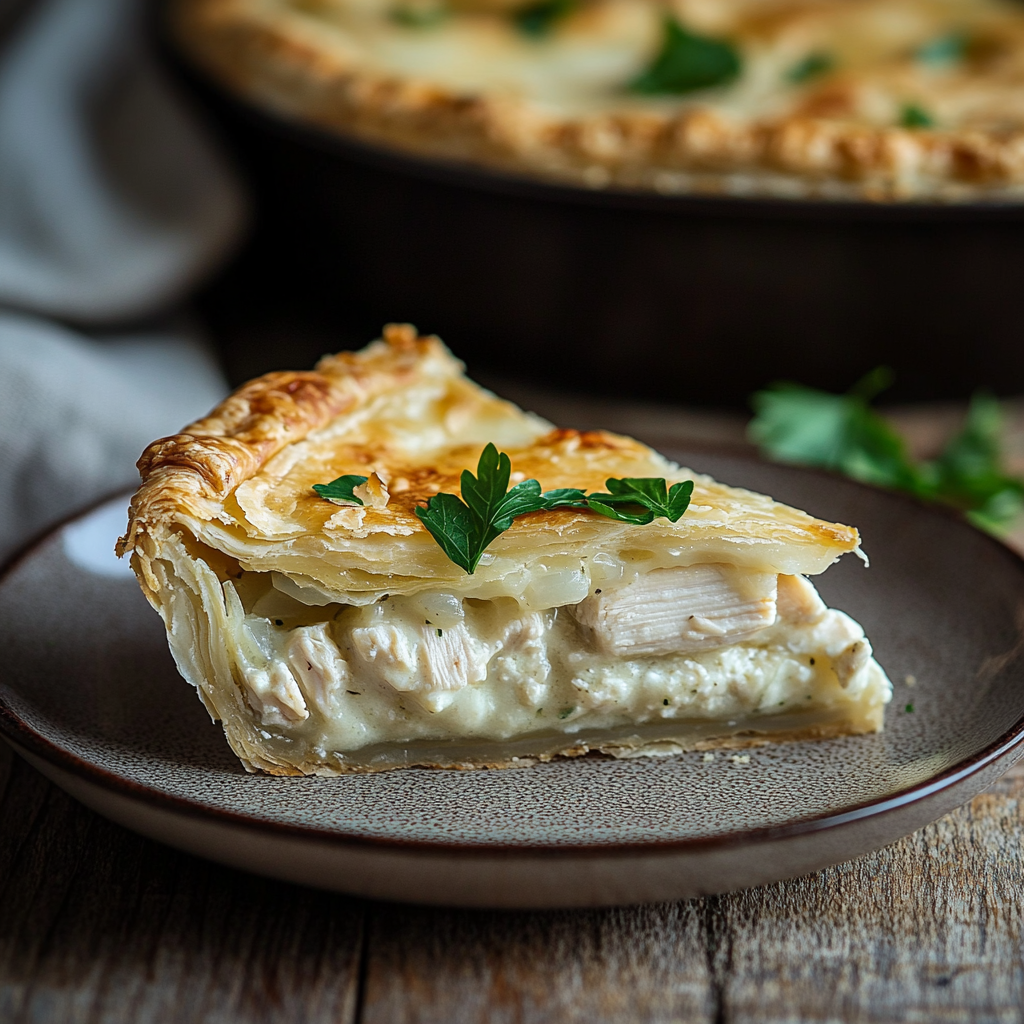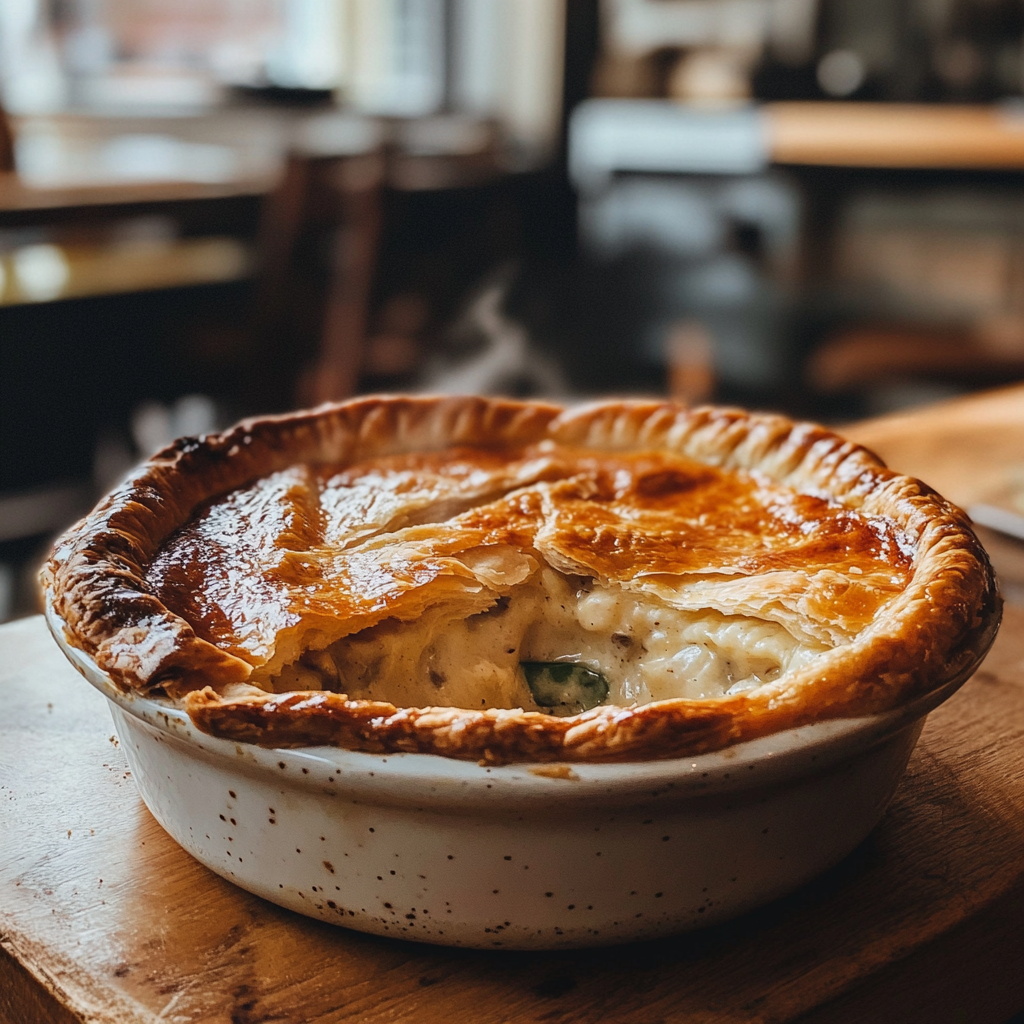Introduction
Chicken pot pie is the epitome of comfort food. With its creamy, savory filling packed with tender chicken, colorful vegetables, and a golden, flaky crust, it’s no wonder this dish has been a household favorite for generations. Perfect for family dinners or special occasions, chicken pot pie brings warmth and nostalgia to the table.
While its exact origins are debated, the idea of encasing a hearty filling within a crust dates back centuries. Today, chicken pot pie stands as a symbol of home-cooked goodness, loved for its versatility and ability to adapt to modern tastes and dietary needs.

Whether you’re a seasoned cook or a beginner, making chicken pot pie is a rewarding experience. This recipe breaks down every step to ensure you can easily recreate this classic dish with confidence.
Ingredients and Preparation for Chicken Pot Pie
The success of a chicken pot pie lies in its perfect balance of a creamy filling and a flaky crust. Choosing the right ingredients and preparing them thoughtfully will elevate your dish from good to unforgettable. Here’s everything you need to know to get started.

Key Ingredients for Chicken Pot Pie
- Chicken: The heart of the dish. Tender, flavorful chicken forms the base of the filling.
- Vegetables: A colorful medley of peas, carrots, celery, and onions adds texture, flavor, and nutrition.
- Creamy Sauce: A combination of chicken broth, milk, and a thickening agent like flour or cornstarch creates the luscious, savory sauce.
- Pie Crust: The crowning glory of any pot pie, the crust should be golden, flaky, and buttery.
- Seasonings: Salt, pepper, thyme, and parsley are essential for flavoring the filling. Optional additions include garlic powder or a dash of nutmeg.
Best Types of Chicken Pot Pie to Use
The type of chicken you choose can make a significant difference in the dish’s texture and flavor:
- Cooked Rotisserie Chicken: A convenient option that saves time and provides excellent flavor.
- Boneless Skinless Chicken Breasts or Thighs: Boil or sauté them for tender, juicy pieces. Thighs are slightly richer in flavor.
- Leftover Chicken: A fantastic way to repurpose roast chicken or even turkey.
The Role of Vegetables and Seasonings for Chicken Pot Pie Recipe
Vegetables bring vibrancy and balance to the rich, creamy filling. Stick to classic options like:
- Carrots and Peas: For sweetness and color.
- Celery: Adds crunch and earthiness.
- Onions: Essential for a savory base.
Seasoning Tips:
- Add herbs like thyme or parsley to enhance the filling’s aroma.
- For an extra burst of flavor, a teaspoon of Worcestershire sauce or Dijon mustard can elevate the savory profile.
Choosing the Perfect Pie Crust: Homemade vs. Store-Bought
The crust can make or break your chicken pot pie. Here’s a guide to picking the best option for your needs:
- Homemade Pie Crust: Ideal if you have time and want the ultimate buttery, flaky texture. Use all-purpose flour, cold butter, and ice water for a foolproof dough.
- Store-Bought Pie Crust: A convenient and reliable option. Look for high-quality brands for the best results.
- Puff Pastry: For a lighter, flakier alternative, puff pastry can be used as a topping.
Ingredient Substitutions and Adaptations for Chicken Pot Pie Recipe
- Dairy-Free Option: Replace milk with unsweetened almond or oat milk and use dairy-free butter for the crust.
- Vegetarian Adaptation: Swap the chicken for mushrooms or plant-based proteins and use vegetable broth instead of chicken broth.
- Gluten-Free Adjustments: Use a gluten-free flour blend for the sauce and a gluten-free pie crust or puff pastry.
Preparation Tips for Chicken Pot Pie Recipe
- Cook the Chicken in Advance: If you’re not using pre-cooked chicken, cook and shred it ahead of time for a smooth workflow.
- Chop Vegetables Evenly: Cutting vegetables into similar-sized pieces ensures even cooking.
- Prepare the Pie Crust: If making homemade dough, chill it in the fridge for at least 30 minutes before rolling out. This helps maintain its structure during baking.
With all your ingredients prepped and ready, it’s time to assemble and bake your chicken pot pie.
Step-by-Step Chicken Pot Pie Recipe Guide
Making a chicken pot pie involves three main stages: preparing the filling, assembling the pie, and baking it to golden perfection. Follow these detailed steps to ensure your pot pie turns out just right.
Preparing the Filling for Chicken Pot Pie Recipe
- Cook the Chicken (If Needed):
- Boil, bake, or sauté chicken breasts or thighs until fully cooked. Allow them to cool slightly, then shred or cube into bite-sized pieces.
- Alternatively, use leftover chicken or rotisserie chicken for convenience.
- Sauté the Vegetables:
- In a large skillet or saucepan, heat 2 tablespoons of butter over medium heat.
- Add diced onions, carrots, and celery. Cook for 5–7 minutes, stirring occasionally, until vegetables are tender but not mushy.
- Add minced garlic and cook for another minute.
- Make the Creamy Sauce:
- Sprinkle 3 tablespoons of flour (or cornstarch for gluten-free) over the sautéed vegetables. Stir to coat evenly.
- Gradually pour in 2 cups of chicken broth, stirring constantly to prevent lumps.
- Add 1 cup of milk (or a dairy-free substitute) and whisk until the mixture thickens into a smooth, creamy sauce.
- Season with salt, pepper, thyme, and parsley to taste.
- Combine Chicken and Vegetables:
- Stir the cooked chicken and frozen peas into the sauce. Let the mixture simmer for 5 minutes to combine flavors.
- Remove from heat and set aside to cool slightly.
Assembling the Pie Chicken Pot Pie Recipe
- Prepare the Pie Dish:
- Preheat your oven to 375°F (190°C).
- Roll out your pie crust (homemade or store-bought) and fit it into a 9-inch pie dish. Let the edges hang slightly over the rim.
- Add the Filling:
- Spoon the prepared chicken and vegetable filling into the pie crust. Spread it out evenly, ensuring there are no air pockets.
- Top with the Second Crust:
- Roll out another pie crust and place it over the filling. Trim excess dough, leaving about half an inch over the edge.
- Press and crimp the edges together to seal the pie.
- Create Steam Vents:
- Use a sharp knife to cut a few small slits in the top crust. This allows steam to escape during baking.
- Optional Egg Wash:
- For a glossy, golden finish, brush the top crust with a mixture of 1 beaten egg and 1 tablespoon of water.
Baking Tips for a Golden, Flaky Crust
- Bake the Pie:
- Place the assembled pie on a baking sheet (to catch any drips) and bake for 40–45 minutes, or until the crust is golden brown and the filling is bubbling.
- Check for Doneness:
- If the edges of the crust brown too quickly, cover them with foil during the last 10–15 minutes of baking.
- Cool Before Serving:
- Allow the pie to rest for 10–15 minutes after removing it from the oven. This helps the filling set and makes slicing easier.

Adjusting Textures and Flavors for Personal Preference Chicken Pot Pie Recipe
- Thicker Filling:
- Add an extra tablespoon of flour or cornstarch to the sauce if you prefer a thicker filling.
- More Seasoning:
- Adjust herbs and spices to taste—add a pinch of nutmeg or a splash of Worcestershire sauce for a richer flavor.
- Extra Vegetables:
- Stir in mushrooms, green beans, or diced sweet potatoes for a unique twist.
Your chicken pot pie is now ready to enjoy!
Tips for the Perfect Chicken Pot Pie Recipe
Crafting the ideal chicken pot pie requires attention to detail and a few insider tricks. These tips will help you avoid common pitfalls and create a dish that’s visually appealing, perfectly textured, and bursting with flavor. How to Make a Perfect Pie Crust
Avoiding Common Pitfalls in Making Chicken Pot Pie
- Soggy Crust:
- Problem: The bottom crust becomes soggy and unappetizing.
- Solution: Pre-bake (blind bake) the bottom crust for 5–7 minutes before adding the filling. This creates a barrier and helps maintain crispness.
- Runny Filling:
- Problem: The filling is too watery and doesn’t hold its shape when sliced.
- Solution: Use the right amount of thickener (flour or cornstarch) and let the sauce simmer until it reaches a thick consistency before assembling the pie.
- Overcooked Vegetables:
- Problem: Vegetables become mushy after baking.
- Solution: Sauté vegetables just until tender-crisp before adding them to the filling.
Techniques for a Crispy and Flaky Crust Chicken Pot Pie
- Chill Your Dough:
- Use cold butter and chill the dough before rolling it out to create a flaky texture.
- Avoid Overworking the Dough:
- Handle the crust as little as possible to prevent it from becoming tough.
- Egg Wash for Shine:
- Brush the top crust with an egg wash (1 beaten egg + 1 tablespoon water) for a glossy, golden-brown finish.
- Prevent Burnt Edges:
- Cover the edges of the pie crust with foil or a pie shield if they brown too quickly during baking.
Enhancing the Flavor of the Filling for Chicken Pot Pie Recipe
- Use Homemade Broth:
- Homemade chicken broth adds depth and richness that store-bought varieties can’t match.
- Incorporate Aromatics:
- Add a bay leaf or a sprig of thyme while the sauce simmers to enhance its flavor.
- Boost Savory Notes:
- A teaspoon of Dijon mustard or a splash of Worcestershire sauce can elevate the filling’s taste.
Pairing Chicken Pot Pie with Sides and Accompaniments
Chicken pot pie is hearty enough to stand alone, but pairing it with the right sides can create a complete meal. Here are some options:
- Light Salad:
- A simple green salad with a vinaigrette dressing adds freshness and balances the richness of the pie.
- Roasted Vegetables:
- Serve with roasted asparagus, Brussels sprouts, or a medley of root vegetables.
- Soup Starter:
- A light soup like tomato bisque or butternut squash soup complements the pie without overwhelming the meal.
- Bread or Rolls:
- Soft dinner rolls or crusty artisan bread are perfect for sopping up any leftover filling.
Storage and Reheating Tips
- Storing Leftovers:
- Allow the pie to cool completely before covering it tightly with plastic wrap or aluminum foil. Store in the refrigerator for up to 4 days.
- Freezing the Pie:
- Wrap the unbaked or baked pie in heavy-duty aluminum foil, then place it in a freezer-safe bag. It can be frozen for up to 3 months.
- Reheating:
- For baked pies, reheat in a 350°F (175°C) oven for 20–30 minutes, or until the filling is hot and the crust is crispy. For unbaked frozen pies, bake directly from frozen at 375°F (190°C) for 60–75 minutes. How to Safely Store and Reheat Leftovers
With these tips, your chicken pot pie will consistently come out perfect.
Frequently Asked Questions for Chicken Pot Pie Recipe (FAQs)
Here are answers to common questions about making chicken pot pie. These tips will help you customize the dish, troubleshoot issues, and maximize its versatility.
Can I Use Leftover Chicken or Turkey?
Yes, leftover chicken or turkey works wonderfully in chicken pot pie. Simply shred or dice the meat into bite-sized pieces and add it to the filling during preparation. This is an excellent way to use Thanksgiving turkey leftovers!
How Do I Prevent the Crust from Becoming Soggy?
A soggy crust can be avoided with these steps:
- Pre-bake (blind bake) the bottom crust for 5–7 minutes before adding the filling.
- Ensure your filling is thick and not overly watery before assembling the pie.
- Use a sturdy pie dish, preferably metal or ceramic, which distributes heat evenly.
Can Chicken Pot Pie Be Made Ahead of Time?
Absolutely! Here’s how:
- Prepare in Advance: Assemble the pot pie but do not bake it. Cover tightly with plastic wrap and refrigerate for up to 24 hours. When ready, bake as directed, adding a few extra minutes to the cooking time.
- Pre-Bake and Store: Bake the pie, allow it to cool completely, and store it in the refrigerator. Reheat it in the oven at 350°F (175°C) for 20–30 minutes before serving.
Can I Freeze Chicken Pot Pie?
Yes, chicken pot pie freezes well, whether baked or unbaked:
- Unbaked Pie: Wrap tightly in aluminum foil and place in a freezer-safe bag. Bake directly from frozen at 375°F (190°C) for 60–75 minutes.
- Baked Pie: Cool completely before freezing. Wrap securely, and reheat at 350°F (175°C) for 30 minutes or until warmed through.
How Do I Make Chicken Pot Pie Gluten-Free?
To make a gluten-free chicken pot pie:
- Use a gluten-free flour blend for thickening the filling.
- Substitute the regular pie crust with a gluten-free crust or puff pastry.
- Double-check that your chicken broth is certified gluten-free.
Can I Use Puff Pastry Instead of a Pie Crust?
Yes, puff pastry is an excellent alternative for a lighter and flakier crust. Simply roll out the puff pastry, place it over the filling, and trim the edges. Bake as directed, keeping an eye on the crust as puff pastry browns quickly.
These FAQs should address any questions or concerns, ensuring your chicken pot pie turns out perfectly every time.
Conclusion
Chicken pot pie is a timeless dish that combines creamy, savory filling with a golden, flaky crust. Whether it’s a cozy dinner for your family or a special treat for guests, this comfort food never fails to delight. With its versatility, you can customize it to suit your preferences—using leftover chicken or turkey, adapting for gluten-free diets, or even trying a puff pastry twist.
The beauty of this recipe lies in its simplicity and adaptability. With just a little preparation, you can create a dish that tastes like it took hours of effort. Pair it with a crisp salad or warm bread for a complete meal, and enjoy the satisfaction of serving a homemade classic.
Now that you have all the tips and steps for success, it’s time to roll up your sleeves and start baking. One bite of this hearty, flavorful chicken pot pie will remind you why it’s such a beloved dish. Share it with loved ones and create delicious memories around the dinner table.

